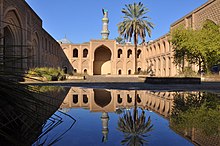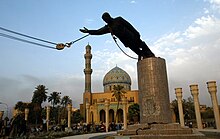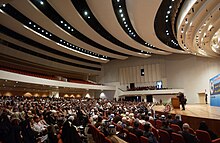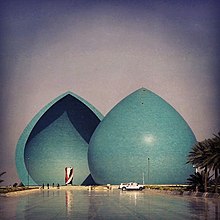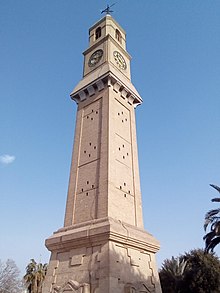Baghdad
Baghdad (Arabic: بَغْدَاد Baġdād, Aramaic: ɐɡɡɔɕ Baghdad) is the federal capital and the most populous city from Iraq. Its number of inhabitants is 8,765,000 (est. 2016), which makes it the largest city in the country and the second in the Arab world, only behind Cairo.
Located on the banks of the Tigris River, the city was founded in the 8th century century and became the capital of the Abbasid Caliphate. In a short time it became a cultural, commercial and intellectual center of great importance in the Islamic world. This, and the fact that it is home to several relevant academic institutions, such as the House of Wisdom, helped the city earn a worldwide reputation as a "Centre of Teaching".
Baghdad was the largest city of the Middle Ages during much of the Abbasid Caliphate, when it reached a peak of one and a half million inhabitants. However, the city was largely destroyed by the troops of the Mongol Empire in 1258, which resulted in a decline that would last for many centuries due to frequent epidemics and the succession of various empires that dominated the city. With the recognition of Iraq as an independent state in 1938 after the disappearance of the British Mandate for Mesopotamia, Baghdad gradually regained some of its past prominence as a significant center of Muslim culture.
In recent times the city has suffered severe damage to its infrastructure, especially during the 2003 invasion of Iraq and the ensuing Iraq war that lasted until December 2011. In recent years the capital has been the target of numerous attacks by the Iraqi guerrilla This military conflict has also caused a deep and irreparable loss of cultural heritage and historical pieces. As a result, Baghdad is considered one of the most inhospitable places in the world to live and offers a very low quality of life.
Origin of name
The name is of pre-Islamic origin and its etymology is disputed.
A villorius of this name existed in the place during the Persian domain, so the name originates in this language, more specifically the average Persian. It's a compound. bagh (![]() ) "God" and dād (
) "God" and dād (![]() "something that is delivered," that is, "gift of God." Many localities in the region have similar names, Baghlan and Bagram in Afghanistan, Baghshan in Iran, and Baghdati in Georgia.
"something that is delivered," that is, "gift of God." Many localities in the region have similar names, Baghlan and Bagram in Afghanistan, Baghshan in Iran, and Baghdati in Georgia.
Some authors have suggested another, older origin, pointing out a Babylonian place-name that can be read as Baghdadu (or rather Hudadu since the cuneiform sign is ambiguous) that also appears in the Babylonian Talmud as Baghdatha. Some authors have considered an Aramaic etymology.
History
Abasid Caliphate and Foundation
In the year 761 Al-Mansur (the Victorious) founded Baghdad, near the ruins of ancient Babylon, and made it the capital of Islam. Mansur believed that Baghdad was the perfect city to be the capital of the Islamic empire under the Abbasid Caliphate, and he was so delighted with the site that he said: "This is really the city that I am founding, where I am living, and where my descendants will reign afterwards.". He developed an economic and capital policy, especially since his situation gave him control of strategic trade routes. It was also an excellent location due to the abundance of water, which was very rare during that time, and its healthy climate.
The caliphate was centered in Damascus, but the lands of Mesopotamia were rich and well populated. With its founding, Baghdad eclipsed Ctesiphon, the capital of the Persian Empire, located about 30 km to the southeast, which had been under Muslim rule since 637, and which was quickly abandoned after Baghdad's founding. Heir to Babylon (which had been abandoned since the II century BC, and whose location was about 90 kilometers to the south) and Seleucia on the Tigris.
The Abbasid Caliphate was heir to the descendants of Muhammad's uncle and was part of the Quraysh tribe. The Abbasids tried to combine the hegemony of the Arab tribes with the ceremonies of the imperial court and the administrative structures of the Persians. The Abbasids consider themselves the heirs of two traditions: the Arab-Islamic (bearers of Muhammad's mantle) and the Persian (successors of the Sasanian monarchs). These two reasons for Al-Mansur to build the capital in a place that was representative of the Arab-Islamic identity through the construction of the House of Wisdom, where ancient texts were translated from their original language, whether Greek or another, into Arab. It is also close to the ancient Sasanian capital of Ctesiphon on the Tigris River.
In 758, Mansur gathered engineers, surveyors, and artists from around the world to draw up plans for the city. More than 100,000 workers participated in the construction, which began on July 23, AD 762. c.
The city was designed as a circle about 2 kilometers in diameter, which was known as the "Ronda de ciudad". The original design called for a ring of residential and commercial structures along the inner part of the city walls, but the final composition added another ring, within the first. In the center of the city stood the mosque, as well as the guard barracks. The circular layout of the city is a traditional Persian Sasanian idea. The ancient Sasanian city of Gur/Firuzabad is almost identical in its circular layout, radiating avenues, and government buildings and temples in the center of the city. Marble was used to make the buildings, many parks, gardens, villas and beautiful walks were built that gave the city an elegant finish.
The four gates of the wall surrounding Baghdad were called Kufa, Basra, Khurasan, and Syria; the names correspond to the exits of the roads to these places. The distance between these gates was a little over two kilometers. Each door has double leaves that were made of iron, they were so heavy that several men were needed to open and close them. The wall was about 44m thick at the base and about 12m thick at the top, and about 30m high, including the battlements. This wall was surrounded by another impressive wall with a thickness of 50 m. The second wall had towers topped by rounded battlements. This outer wall was protected by a solid embankment made of bricks and lime. Beyond the outer wall was a moat filled with water.
In the center of Baghdad, in the central square was the Palace of the Golden Gate. It was the residence of the caliph and his family. In the central part of the building there was a 49 m high green dome. The palace was close to other mansions and residences of officials. Near the Syrian Gate, a building served as a barracks for the guards. After the death of Caliph Al-Mansur, the palace ceased to be the residence of the Caliph and his family, moving to the Palace of Eternity, on the banks of the Tigris. Baghdad reached its peak in the reign of Caliph Haroun al-Rashid, who, however, felt a deep dislike for the city, which he called "the sauna", deploring its sweltering heat and the dust clouds coming from the desert. Because of this he transferred his residence to Raqqa, on the upper Euphrates, leaving the government of the Caliphate in the capable hands of the Barmakids, who installed a parallel court of great cultural splendor.
The city had become a major political, economic, military, cultural and artistic center, so that in the 19th century IX was one of the largest cities on Earth, with an estimated population of 700,000 or even more, a population comparable only to Constantinople or Chang'an. It was the Baghdad of Las a thousand and one nights, of the souks, the mosques, the palaces, the beautiful Arab princesses, the merchants who went up the Tigris bringing all kinds of products, silks and carpets. A part of the population of Baghdad was not Arab, and there were Persian, Aramaic and Greek settlers, but these communities progressively adopted the Arabic language.
In the eastern part of the city, a Christian community was founded by the Byzantine garrison of the border castle of Samalu, transferred to Baghdad after its capture in the course of an expedition commanded by Harun al-Rashid in the summer of 780. Its The church, known as Dayr al-Rum ('the monastery of the Greeks'), was the center of Christian life in the city until the Mongol conquest of 1258.
In 813, due to the civil war between the sons of al-Rashid, Caliph Al-Amin and his brother Al-Mamoun, Baghdad was subjected to a long siege by the troops of Tahir ibn Hussein. The siege was especially long and bloody, fighting street by street. Much of the city was destroyed, including the Palace of Eternity, seat of the Caliphate. When the victorious al-Mamoun moved from Merv to the city of his ancestors in 819 he undertook a rebuilding effort, building a new palace and founding in 827 the celebrated House of Wisdom (Bait al-Hikma), dedicated to the translation of works from Greek, Persian and Medo-Syriac, scholars from all over the empire went to Baghdad facilitating the introduction of Greek and Indian science into the Arab and Islamic world. Following serious disturbances in 835, the caliph decided to abandon Baghdad and settle in a newly built city, Samarra, which would be the capital of the Abbasids until al-Mutamid moved back to Baghdad in 892.
The Seljuks were a clan of Oghuz Turks from the Siberian steppe who converted to the Sunni branch of Islam. In the year 1040 they destroyed the Ghaznavid Empire and in 1055, Toghrül the chief of the Seljuks conquered Baghdad. The Seljuks ousted the Buyids, a Shiite dynasty that ruled for some time and seized power and control of Baghdad. They proclaimed themselves sultans in the name of the Abbasid caliphs.
Invasions and Ottoman Empire
As of the century X it declined due to the disintegration of the Abbasid caliphate into various independent caliphates and in 1258 it was razed by the Mongols, led by Hulagu, grandson of Genghis Khan. The Mongols massacred most of the inhabitants, including Caliph Al-Musta'sim, and destroyed much of the city. The canals and dikes that formed the city, as well as the irrigation system, were also destroyed. The sack of Baghdad ended the Abbasid Caliphate, and as a consequence Islamic civilization never fully recovered. At that time Baghdad was ruled by an Ilkhanate, one of the four divisions of the Mongol Empire, which was centered on Persian land. In 1401, Baghdad was sacked again, by Timur ("Tamerlane").
The city fell into decline and in 1534 it was conquered by the Ottoman Turks. In 1921 the city became the capital of Iraq under British Mandate until the country's final independence in 1932. The city's population grew from an estimated 145,000 in 1900 to 580,000 in 1950, of whom 118,000 were Jews.
From independence to the present day
In 1958 the Iraqi army deposed the monarch, Faisal II, forming a government from which Saddam Hussein would emerge. During the 1970s, Baghdad experienced a period of prosperity and growth due to a sharp increase in the price of oil. Modern infrastructures including water, sewerage and roads were developed.
The Iran-Iraq war, which began in 1980, was a difficult time for the city, as Iran launched a series of missile attacks on Baghdad. Later, the city was attacked again during the Gulf War in 1991. In 2003, the United States bombed Baghdad, starting the Iraq war, in which numerous military and government targets were destroyed, such as Hussein's presidential palace.
The Coalition Provisional Authority took over local government until the end of June 2004, and was later dissolved, after ceding power to city institutions. During the occupation, a maximum security area, known as the Green Zone, was created where the government district was protected from terrorism. The so-called insurgency, caused for years a large number of terrorist attacks throughout Baghdad, with a high number of victims, as well as clashes between the country's Sunni and Shiite factions. The international occupation ended in 2011.
Geography and climate
The city is situated on a vast plain divided by the Tigris River. This divides Baghdad in two, the eastern half, also known as "Rusafa", and the western half, the "Karkh". The land where the city itself is located is flat and low, the product of an original flood due to the long and periodic floods caused by the river.
Baghdad has a very hot and arid climate (BWh, according to the Köppen table), being one of the hottest cities in the world. During the summer season, from June to August, the average temperature is 34.8 °C, accompanied by a scorching sun. Rain is practically unknown in the area in that season. During the day, the thermometers can shoot up to 51 °C in the shade and at night go down to 20 °C. Baghdad's all-time high temperature is 51.8 °C recorded on July 29, 2020. Humidity is also very low due to the city's distance from the Persian Gulf, which helps frequently form summer dust storms born in the desert.
During the winter, from December to February, temperatures are noticeably milder. The maximum ranges between 25 and 26 °C and the minimum is usually above -6 °C, although it is not uncommon in Baghdad to experience temperatures in winter below -10 °C. The presence of the Tigris attenuates the effect of continentality.
Annual rainfall is limited to the period from November to March, with averages of around 140 mm with maximum records of 215 and minimums of 0 mm. On January 11, 2008, an unusual scene took place in Baghdad, as the city woke up covered in a thin layer of ice, the first in a hundred years.
| Month | Ene. | Feb. | Mar. | Open up. | May. | Jun. | Jul. | Ago. | Sep. | Oct. | Nov. | Dec. | Annual |
|---|---|---|---|---|---|---|---|---|---|---|---|---|---|
| Temp. max. abs. (°C) | 24.8 | 27.1 | 30.9 | 38.6 | 43.5 | 48.8 | 50.0 | 49.9 | 47.7 | 40.2 | 35.6 | 25.3 | 50.0 |
| Average temperature (°C) | 15.5 | 18.5 | 23.6 | 29.9 | 36.5 | 41.3 | 44.0 | 43.5 | 40.2 | 33.4 | 23.7 | 17.2 | 30.6 |
| Average temperature (°C) | 9.7 | 12 | 16.6 | 22.6 | 28.3 | 32.3 | 34.8 | 34 | 30.5 | 24.7 | 16.5 | 11.2 | 22.8 |
| Temp. medium (°C) | 3.8 | 5.5 | 9.6 | 15.2 | 20.1 | 23.3 | 25.5 | 24.5 | 20.7 | 15.9 | 9.2 | 5.1 | 14.9 |
| Temp. min. abs. (°C) | -11.0 | -10.0 | -5.5 | -0.6 | 8.3 | 14.6 | 22.4 | 20.6 | 15.3 | 6.2 | -1.5 | -8.7 | −11 |
| Rains (mm) | 27.2 | 19.1 | 22.0 | 15.6 | 3.2 | 0 | 0 | 0 | 0 | 3.3 | 12.4 | 20.0 | 122.8 |
| Days of rain (≥ 0.001 mm) | 8 | 7 | 8 | 6 | 4 | 0 | 0 | 0 | 0 | 4 | 6 | 7 | 50 |
| Hours of sun | 192.2 | 203.3 | 244.9 | 255.0 | 300.7 | 348.0 | 347.2 | 353.4 | 315.0 | 272.8 | 213.0 | 195.3 | 3240.8 |
| Relative humidity (%) | 71 | 61 | 53 | 43 | 30 | 21 | 22 | 22 | 26 | 34 | 54 | 71 | 42.3 |
| Source No. 1: World Meteorological Organization (UN) | |||||||||||||
| Source No. 2: Climate & Temperature | |||||||||||||
Government
The city of Baghdad has 89 official neighborhoods within 9 districts. These subdivisions of the city served as administrative centers for the distribution of municipal services but until 2004 they did not have a specific political function. At the beginning of April 2003, the United States controlled the Coalition Provisional Authority (CPA) beginning the creation of new functions for them. The process initially focused on the election of neighborhood councils in the official neighborhoods themselves, elected by local caucuses. The CPA convened a series of meetings in each neighborhood to explain local government, describe the caucus election process, and encourage public participation. Each process in the neighborhoods ends with a local meeting where the candidates for the local councils do self-advertising and electoral campaigning. Each ward council elects its representatives from among its members to serve on one of the city's nine ward councils. The number of ward representatives on a district council is based on the population of each ward. The next step is for each of the nine district councils to name their elected representatives, to form the 37-member Baghdad City Council. This system of local government connects the people of Baghdad with the neighborhoods, districts and the city council.
The same process is used to appoint representative councilors for the other communities in Baghdad province, outside of the city itself. There, the local councils of twenty neighborhoods (Nahia) are elected and these councils elect representatives from among their members to act in the six district councils (Qada), in the same way that within the city, the district councils elect representatives of among its members to name the 35 members of the Baghdad Regional Council.
The final step in establishing the system of local government for Baghdad province is the election of the Baghdad Provincial Council. As before, the representatives of the Provincial Council were elected proportionally with the population level of the districts they represent. The 41 members of the Provincial Council took office in February 2004 and served until the national elections held in January 2005, when the new Provincial Council was elected.
This system of 127 separate councils may seem cumbersome, but Baghdad province has around 7 million people, which at the very least, each council represents an average of 74,000 people.
The nine administrative districts are:
- Adhamiyah
- Karkh
- Karadah
- Kadhimiya
- Mansour
- Sadr City-Thawra
- Rasheed
- Russian
- New Baghdad (9 Nissan)
Culture
Baghdad has always played an important role in Arab cultural life and has been home to prominent writers, musicians and artists. The dialect of Arabic spoken in Baghdad today differs from that of other major urban centers in Iraq. This may have been caused by the repopulation of the city with residents from rural areas in the Late Middle Ages.
Some of the city's important cultural institutions include:
- National Symphony Orchestra of Iraq. The trials and performances were briefly interrupted during the Second Gulf War, but since then they have returned to normal.
- National Theatre of Iraq. The theatre was plundered during the 2003 invasion of Iraq, but it is trying to restore. The theatre received a boost during the 1990s when UN sanctions limited the import of foreign films. At least thirty cinemas had been converted to theatrical scenarios, producing a wide range of comedies and dramatic productions.
Some institutions that offer cultural education in Baghdad are the Academy of Music, the Institute of Fine Arts, and the Baghdad School of Music and Ballet. Baghdad is also home to a number of museums housing artifacts and relics from ancient civilizations, several of which were looted during museum looting sparked by the widespread chaos after US forces entered the city.
During the occupation of Iraq in 2003, the American Forces Network radio station (called "Freedom Radio", i.e., Radio Freedom) began broadcasting news and entertainment programs with reach to the entire Baghdad and nearby towns. There is also a radio station called "Dijlah" (Arabic name for the Tigris River), created in 2004 as the first independent radio station in Iraq. The offices of Radio Dijlah, in the Jamia neighborhood of Baghdad, have been attacked on several occasions.
Sights and Monuments
Points of interest include the National Museum of Iraq, whose valuable collection of artifacts was looted during the 2003 invasion, and the Hands of Victory arches. Multiple Iraqi parties have debated whether the arches should remain historical monuments or be dismantled. Thousands of ancient manuscripts housed in the National Library and Archives of Iraq were destroyed when the building caught fire during the invasion of Iraq in 2003. The Al Kadhimain Shrine, in northwest Baghdad (in Kadhimiya), is one of the most important sites Shia religious in Iraq. It was completed in 1515 and the 7th (Musa ibn Jafar al-Kathim) and 9th (Mohammad al-Jawad) Imams were buried there. One of the oldest buildings is the Abbasí Palace. The palace is part of the central historical area of the city and is located close to other buildings of historical importance such as the Saray Building and the Al-Mustansiriyah School (from the Abbasid period). There are other places in Baghdad, each of them representing a historical era:
- Tower of Baghdad (now the tower of the Ma'amoon Telecommunications Center) - was the highest point in the city, and from where the entire city was seen. The construction of the tower marks the period of the post-war Gulf of 1991, with the reconstruction efforts of the city.
- The two-level bridge in Jadriyah (Jisr Abul Tabqain). While the construction plans for this bridge were prior to Saddam Hussein's government, the bridge did not build. As part of recent reconstruction efforts, the bridge has been built. Connect the Al-Doura area with the rest of Baghdad and complete the 14th of July bridge.
- Sahat Al Tahrir (Plaza de la Liberación), in the centre of Baghdad.
- Baghdadi Museum, Wax Museum
- Mustansiriya School, a century Abbey StructureXIII.
- Al-Zawra'a Park in the Al-Mansour Area and almost in the centre of Baghdad.
- Kahramana Square and the forty thieves.
- Hotel Al-Rasheed
- Monument Al Jundi Al Majhool (Monumento al Soldado Desconocido).
- Monument Al Shaheed, a monument to Iraqi soldiers killed in the Iran-Irak war, located on the eastern shore of Tigris.
- A great road built under the Saddam regime as a route for the parades, which runs through the Victory Hands, a couple of huge cross swords, built in honor of the soldiers who died in the Iran-Irak war during the Saddam government.
Baghdad Zoo
The Baghdad Zoo was the largest zoological garden in the Middle East. After the first eight days of the 2003 invasion, only 35 of the 650 to 700 animals in the facility survived. For some, this was the result of the theft of some animals for human food, and the hunger of the animals in cages that had no food or water; moreover, this was still one more of the propaganda that was spread to increase the repudiation of Saddam Hussein and not tell the truth, which was the product of the permanent, intense and indiscriminate bombardments of the US army to the city.[citation needed] Among the survivors are the larger animals, such as lions, tigers and bears. However, after the chaos generated by the invasion, South African Lawrence Anthony and some of the zookeepers protected the animals and fed the carnivores meat from donkeys. Paul Bremer ordered the protection of the zoo, and American engineers helped reopen the premises.
Looting of cultural heritage in Baghdad
The two Gulf wars greatly affected the cultural heritage of Baghdad, and, in general, throughout Iraq.
Since ancient times, the cities built by the Iraqis were abandoned and destroyed, forming small hills, scattered throughout the country. They are called tells and under these tells are depositories of evidence that had not been excavated for the most part. It is estimated at more than 10,000 the number of these archaeological sites on Iraqi territory containing unknown pieces of Sumerian, Babylonian and Assyrian culture. It is not known how many such tells still exist.
Many archaeologists compare the dispossession of this legacy with the destruction of the Library of Alexandria, or with the destruction caused in Constantinople by the fourth Christian crusade (in 1204, under the papacy of Innocent III).
Although the looting of archaeological artifacts and works of art in Mesopotamia is not new, since the 19th century they have been illegal excavations, theft and smuggling of the cultural and artistic heritage of the Middle East taking place. This looting has nurtured large collections of Mesopotamian antiquities, such as those of the British Museum or the Louvre.
The looting of treasures preserved in Iraq over the centuries has increased since the Gulf War (carried out by George H.W. Bush in 1991), and reached its climax with the looting of the Baghdad Museum when the United States occupied that city. Since then, tens of thousands of works have begun to appear on the antiquities markets of Europe and the United States. The number of definitively lost objects is estimated at around 200,000. Among those, the disappearance of a gold harp from the Sumerian era, which is the first known musical instrument (3000 BC). The University of Mustansyria, founded in the 13th century, was one of the oldest universities in the world and was destroyed during the war of the Gulf. Another fact that contains irreversible effects is the burning of the National Library of Baghdad, which treasured medieval manuscripts. These manuscripts were sources related to the Jewish, Islamic and Christian tradition. Among the treasures of the National Museum in Baghdad was the most important collection of Mesopotamian antiquities in the world. Among these antiquities were thousands of cuneiform clay tablets, most of which were never deciphered. His current whereabouts are unknown.
Religion
Islamic
The situation in the Iraqi capital after the fall of Saddam Hussein in March 2003 is complex: with the appearance of new political groups, the reawakening of traditional religious movements, the return of those who lived in exile, the religious leaders and the influence of neighboring countries.
Increased tensions led to several terrorist attacks and armed conflicts between Sunnis and Shiites against each other. Ethnic cleansing has been extensive, yet violence declined in 2007 between religious groups. One of the reasons is that there are hardly any heterogeneous districts, so there is pre-planning for attacks. Another reason for the reduction in violence is the presence of the United States military, which separates the Shiites and the Sunnis.
95% of the population of Iraq is Muslim. That is why there are many mosques in Baghdad, the most famous of which is the Abu Hanifa Mosque. Before the 2003 invasion, 65% of Muslims were Sunni and 35% Shia.
Christianity
Christianity has existed in Iraq since the earliest times and the various Iraqi Christian churches have had strong roots. During the government of Saddam Hussein (after all, from a secular party) there was extensive religious freedom. The government came to have Christian ministers such as the former Chaldean Catholic prime minister Tariq Aziz. About half of the Christians in Iraq live in Baghdad. Its proportion in the total population until March 2003, which was around 10%, decreased due to the crises in Iraq until 2006, to around 5%.
Since the start of the war, according to the Auxiliary Bishop of Baghdad, Andreas Abouna, around 75% of the Christian population had left the capital, seeking protection in the Kurdish north of Iraq, or in neighboring countries such as Turkey, Syria and Jordan.
The Patriarch of Babylon, based in Baghdad, heads the religious organization of the Chaldean Catholic Church. The Latin Church forms the Archdiocese of Baghdad.
Baghdad is also the historic seat of the patriarch of the Assyrian Church of the East. The bishops of the Syrian Orthodox Church of Antioch, formerly organized as the "Maphrianat of the East," also have their headquarters in Baghdad.
Judaism
The presence of the Jewish population in Baghdad dates back to the times of the ancient city of Babylon. The Persian king Cyrus II the Great conquered this city and allowed the return of the Jews to his land. However, many decided to stay, prospering there, and also suffering persecution, until the times of the Abbasid Caliphate and the Ottoman Empire. After the independence of Israel in 1948 and the Arab-Israeli war of that same year, riots against the Jews were repeated. The Israeli government carried out Operation Ezra and Nehemiah, with the goal of moving, beginning in 1952, approximately 95% of Jewish Iraqis via airlift. On July 25, 2003, six of the The last of Baghdad's Jews flew to Israel. By 2011 the number of Jews in the city had dropped to just seven.
Sports
Baghdad is home to some of the biggest soccer teams in Iraq, the biggest being Al Quwa Al Jawiya (Aviation Club), Al Zawra, Al Shurta (Police) and Al Talaba (Students). The largest stadium in Baghdad is the Al Shaab Stadium which was inaugurated in 1966.
The city has also had a strong tradition of horse racing since World War I. Islamists have pushed to end this tradition, because the sport has a significant betting sequence.
Twin cities
- Cairo, Egypt, since 1998
- Haman (Jordan, since 1989)
- Beirut, Lebanon
- Saná (Yemen, since 1989)
- Denver, United States
- Monterrey, Mexico
- Paraguay (Venezuela)
Notable people
Contenido relacionado
XIV century
12th century BC c.
1944


